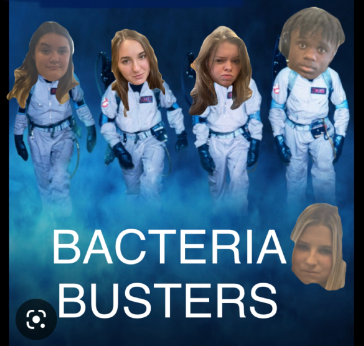Bacteria Busters: Exposing the Spread of Bacteria at ACAD

February 10, 2023
The INVESTIGATION:
In an attempt to discover the intensity of the bacterial situation around the Athens Academy campus, the Bacteria Busters of Honors Evolutionary Genetics set to work. We first carefully chose the locations that we knew would be the most contaminated with bacteria based on location, activity, and how often they were cleaned.
- Williams girls bathroom handle on sink
- Phone holder in Ms. Neves’s room
- Tillman center drink fridge handle
- Mr. Callahan’s computer
- Tillman keypad
- Tillman kitchen counter
- Williams boys bathroom floor
- Williams door inside handle
The PROCEDURE:
Next, the Bacteria Busters experimented on their chosen locations’ bacteria, growing the bacteria so that they could be seen with the naked eye.
- Each group chose their locations and collected 3 Petri dishes as well as 3 swabs.
- Each petri dish was labeled 1-3 accordingly.
- First, we swabbed directly from the object being tested and then rubbed gently onto the plate without allowing too much outside bacteria in. Next, we immediately closed it and set it aside.
- We rubbed our hands on the testing area to collect bacteria and then swabbed our hands, rubbing gently onto the plate without allowing too much outside bacteria in, then immediately closed the dish and set it aside
- Next, we washed our hands thoroughly then swabbed our clean hands, rubbed gently onto the plate without allowing too much outside bacteria in, then immediately closed the dish and set it aside
- We made sure all the plates/dishes were closed and taped if necessary, and placed them into the incubator.
- (After swabbing) We placed all of our materials into a bleach bucket.
The RESULTS:
In order to keep our campus safe and sanitary, we, as Bacteria Busters, have the responsibility to study our results from this experiment in order to find a solution that ensures the cleanliness of our school. That way we can know how to successfully avoid and destroy the types of bacteria that are common on campus.
Our Results:
- All Petri dishes came back with a variation of sizes of circle colonies
- The different spots range from pale yellow to neon yellow
- Same results on the petri dish when collecting the bacteria from our hands after touching hot spot areas
- After washing our hands and swabbing them, the Petri dishes contained little to no bacteria
- Washing your hands is vital to get rid of bacteria
How to BUST BACTERIA
It is no secret that the Athens Academy campus is positively haunted by millions of kinds of bacteria, including the ones we collected in class. And to make matters worse, a survey conducted by Ms. Neves and distributed among over two hundred community members revealed that most people, upon getting infected with a bacterial sickness, do not administer antibiotics correctly. Luckily, however, the CDC (Center for Disease Control) provides countless examples of methods one can use to not only prevent the contraction of bacteria and also to correctly combat it with antibiotics if needed.
Prevent the spread:
The CDC offers countless examples of habits one can practice in order to prevent the spread of bacteria, especially those that are gram-negative (resistant to antibiotics). Some basic practices to bust bacteria before they have the chance to infect include:
- Washing Hands
- According to the CDC, the most effective way to prevent infections is to wash your hands with soap and water, for a minimum of twenty seconds per wash. When one washes their hands, they prevent the spread of germs by removing them from their skin, therefore, decreasing the possibility of the bacteria infecting themselves and others.
- Vaccination
- Vaccines are an effective way of preventing infections, including strains that are gram-negative. They train the immune system to combat bacteria and can effectively prevent one from contracting infections.
- Use Antibiotics Appropriately
- According to the results of the Evolutionary Genetics survey on the usage of antibiotics in our community, many people have fallen victim to using them incorrectly. So how can one safely and correctly administer antibiotics? The CDC offers some advice:
- Only take antibiotics administered by a doctor or healthcare professional.
- Do not take antibiotics that are out of date or have expired.
- Do not save antibiotics for a later date when they might be needed.






















